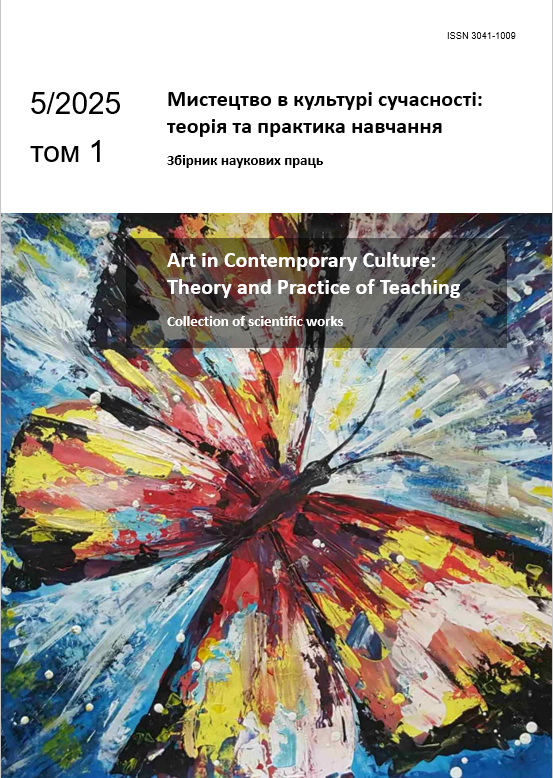SCIENTIFIC APPROACHES TO THE FORMATION OF ENSEMBLE SINGING SKILLS OF FUTURE TEACHERS OF MUSIC ART
Published 2025-05-15
Keywords
- уміння ансамблевого співу, майбутні вчителі музичного мистецтва, індивідуально-творчий, системно-ціннісний, трансдисциплінарний, діяльнісний підходи

This work is licensed under a Creative Commons Attribution 4.0 International License.
How to Cite
Abstract
The article reveals scientific approaches to the formation of ensemble singing skills of students of faculties of arts in the process of vocal training. The concept of "formation of ensemble singing skills" is revealed as one of the fundamental segments of the process of professional training of future teachers of musical art, which is the key to the development of vocal and choral culture, which is the strategic goal of musical art lessons at school. Individual-creative, system-value, transdisciplinary, activity approaches are distinguished.
The individual-creative approach has as its scientific basis the personally-oriented parameters of the professional activity of the future teacher of musical art. In the context of the individual-creative approach, we interpret the activity as a product of personal creativity, the result of the professional development of students, creators of a new educational space. The system-value approach is based on taking into account the system of values in the individual matrix of each student, directing them to understand themselves as creators of new ideas and new actions in vocal activity, aimed at obtaining their own new artistic result. The transdisciplinary approach considers the means of combining the opposites of various characteristics of any process according to the principle of complementarity, which allows creating such a basis for vocal training that ensures the formation of students' competence in the field of innovative problem solving at the border of knowledge of different disciplines. This important approach takes into account the change in the usual course of vocal training due to openness to interpretations, analysis and transfer of information, the tools for organizing various feedback and predicting risks, the focus on obtaining new facets-characteristics, unpredictable-random qualities, new ideas and new ways of action. The activity approach provides consideration of the professional activity of a future teacher of musical art, which is determined by: individual skill; the possibility of renewal; the successful implementation of transformative action; motivation of the innovative teacher for his own activity as a mobile process of updated creative solution of educational and artistic tasks in order to provide students with innovative tools for original and independent creative action.
Downloads
References
- Бевз Г. М. Трансдисциплінарний підхід у психологічних дослідженнях реформи освіти як складного явища. Вісник післядипломної освіти: зб. наук. праць. Серія «Соціальні та поведінкові науки». Київ, 2022. Випуск 22(51). С. 28-46, С. 31. Режим доступу: http://umo.edu.ua/socialjni-ta-povedinkovi-nauki-vipuski/zbirnik-naukovikh-pracj-visnik-pisljadiplomnoji-osviti-serija-socialjni-ta-povedinkovi-nauki-vipusk-2251-2022. Дата звернення 17, 06. 2023
- Бичко І. В. Філософський енциклопедичний словник. Київ: Інститут філософії імені Григорія Сковороди НАН України: Абрис, 2002. 742 с.
- Інноваційні технології навчання в умовах модернізації сучасної освіти: монографія / за наук. ред. д. пед. н., проф. Л. З. Ребухи. Тернопіль : ЗУНУ, 2022. 143 с.
- Козир А. В. Федоришин В. І. Вступ до акмеології мистецької освіти: навч.-методич. посіб. Київ: Вид-во НПУ імені М.П. Драгоманова, 2012. 263с.
- Kuutti Kari. Activity theory, transformation of work, and information systems design. Perspectives on activity theory. Publisher Cambridge University Press, 1999. pp. 360-376.
- Maslow A. H. Religions, values and peak-experiences. New York: Free Press of Glencoe, 1961. 208 p.
- Nardi B. A. Activity theory and human computer interaction. Context and Consciousness: Activity Theory and Human-Computer Interaction. Cambridge, Massachusetts: The MIT Press. 1996. pp. 1-8
- Rockefeller S. C. John Dewey: Religious Faith and Democratic Humanism. New York : Columbia University Press, 1994. 683 p.
- Rogers Carl. El camino del ser. Madrid : Publisher : Editorial Kairós, May 25, 2007. 200 p.
- Tkach M., Oleksiuk O., Bobyk L. Non-linear thinking strategies in post-non-classical higher art education: A synergistic concept Scientific Herald of Uzhhorod University, Series “Physics”, 2024. Т. 55. Режим доступу: https://elibrary.kubg.edu.ua/id/eprint/49211/1/M_Tkach_O_Oleksiuk_%20NLTSPCHAE_FMMH_KMMO.pdf Дата звернення 20.05. 2024
- Torrance E. P. The Nature of Creativity as Manifest in its. Testing Sternberg R.J. Cambridge: Cambridge Univ. Press, 1988, р. 32-75
- Twiss B. C. Managing technological innovation. London : Longman, 1980. 240 p.





